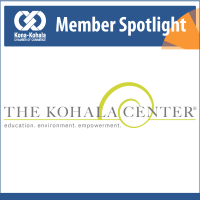Kahalu‘u Bay on Hawaii's West Coast Recognized as a Mission Blue Hope Spot

On the west coast of the island of Hawai‘i is Kahalu‘u Bay, also known as ‘āina lei ali‘i, lands that adorn the chiefs. It is a wahi pana, a sacred, celebrated, and storied place abundant with cultural and ecological treasures.
Cindi Punihaole, director of The Kohala Center’s Kahalu‘u Bay Education Center (TKC-KBEC) and Dr. Christine Zalewski, president of Dear Ocean, are working to preserve Kahalu‘u Bay for generations to come. Punihaole describes how her native Hawaiian upbringing shapes her perspective and approach to conservation at Kahalu‘u Bay. “We were taught that taking care of the ʻāina, the land and sea, is your survival. It’s second nature for me to look at what gives us life.”

International marine conservation nonprofit Mission Blue has named Kahalu‘u Bay a Hope Spot and Punihaole and Zalewski as the Hope Spot Champions. Kahalu‘u is the 141st Hope Spot worldwide and the second Hope Spot in the state of Hawai‘i.
Dr. Sylvia Earle, Founder of Mission Blue, says, “Kahalu‘u Bay serves as a model for other smaller bays around the world and shows how they too can harness the deep relationships between people and the environment to protect these cherished places. [the] Bay has become a beacon of hope and a source of inspiration for the community.”

Kahalu‘u translates to “diving place” in English and is distinguished by its clear, shallow waters and diverse marine life. Kahalu‘u Bay has supported the community for centuries, providing food for local residents and serving as a sacred link to ancestral heritage. More recently, the bay has also served as a snorkeling destination for visitors from all over the world as they come to experience its rich natural and cultural resources.
The bay and its surrounding waters are home to several endangered and threatened species, such as ʻIlio holo i ka uaua (Hawaiian monk seals), Koholā (humpback whales), Honu (green turtles) and Honu‘ea (hawksbill turtles). It is also a critical habitat for hundreds of fish and invertebrate species, of which approximately a quarter are endemic, meaning they can be found nowhere else in the world. Juvenile fish utilize the calm shallow waters of Kahalu‘u Bay to mature, often overflowing and feeding the larger connectivity corridor along the Kona Coast.
However, the safe and shallow nature of Kahalu‘u Bay is a bit of a double-edged sword. Over the last several decades, the natural and cultural resources of the park have been degraded by an increase in several chronic stressors including impact from more than 400,000 beachgoers each year, poor water quality from nearby cesspools, increased runoff from development, coastal damage from rising sea levels, and climate change.
Punihaole and Zalewski have seen Kahalu‘u change over the years, and both of their organizations aim to reverse the damage brought upon the bay through these anthropogenic stressors.
Read the article: https://mission-blue.org/2022/05/kahaluu-bay-on-hawaiis-west-coast-recognized-as-a-mission-blue-hope-spot/
About Kahalu‘u Bay Education Center
Kahaluʻu Bay Education Center (KBEC), a program of The Kohala Center (TKC), was established in 2007 to promote reef-friendly practices to visitors in an effort to protect Kahaluʻu Bay’s fragile ecosystem through education, research, and advocacy. The staff and volunteers at TKC-KBEC work every day to protect marine life in Kahaluʻu Bay.
TKC-KBEC works with local and state governments, NGO’s, and businesses, Hawaiʻi Island residents, scientists, and visitors from around the world to integrate ancestral knowledge with Western science to foster sustainable practices at the bay.
Kahalu‘u Bay Education Center Facebook
 KONA, HAWAI‘I (May 26th, 2022) https://mission-blue.org/2022/05/kahaluu-bay-on-hawaiis-west-coast-recognized-as-a-mission-blue-hope-spot/
KONA, HAWAI‘I (May 26th, 2022) https://mission-blue.org/2022/05/kahaluu-bay-on-hawaiis-west-coast-recognized-as-a-mission-blue-hope-spot/

-Horizontal-P301-w1920.png)
